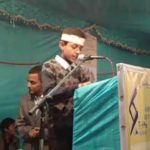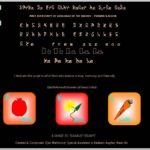
Punjabi Language:
Punjabi is an Indo-Aryan language spoken by over 100 million native speakers worldwide, ranking as the 10th most widely spoken language in the world. The language is said to have developed in the late 10th century. It is the native language of the Punjabi people, who reside mainly in the Province of Punjab in Pakistan, but also neighbouring State of Punjab in India.
The word “Punjabi” is derived from “Punjab” – this word is derived from the Persian words “Panj” (پنج) meaning five and “Ab” (آب) meaning water; hence “Five Water” which is in reference to the five major eastern tributaries of the Indus River, which flow through Punjab – the Chenab, Jhelum, Ravi, Sutlej and Beas rivers.
Gurmukhi Script:
Since the Sikhs in India speak Punjabi as their predominant language, their holy book Guru Granth Sahib, employs Punjabi language, written in Gurmukhi alphabet. The Gurmukhi alphabet is derived from the Landa alphabet that has roots in the Brahmi alphabet. Second Sikh Guru Angad (1539-1552) enhanced the Gurmukhi alphabet to its current state for the express purpose of writing the holy book, giving rise to the slogan “Guru’s mouth.” Punjabi is not the only language used in Sikh scriptures; the GGS has several other languages interspersed with Punjabi, including – Persian, Sanskrit, Brajbhasha and Khariboli – all written using the Gurmukhi alphabet though.
Modern Gurmukhi has 41 consonants (vianjan), nine vowel symbols (lāga mātrā), two symbols for nasal sounds (bindī and ṭippī), and one symbol which duplicates the sound of any consonant (addak). In addition, four conjuncts are used: three subjoined forms of the consonants Rara, Haha and Vava, and one half-form of Yayya. Use of the conjunct forms of Vava and Yayya is increasingly scarce in modern literature.
Pakistani Punjabis have been using the Shahmukhi alphabet from the times of the Muslim and later Mughal Empires in the region and thus the term “from King’s mouth.” Shahmukhi is a modification of the Persian-Nasta’liq alphabet – meaning, the direction of writing is right to left, while that for Gurmukhi is left to right.
Devanagri alphabet for Punjabi language is mostly used by Hindus living in the neighboring states of India’s Punjab, which include Haryana, Himachal Pradesh and parts of Rajasthan.
Shahmukhi Script:
Shahmukhi (شاہ مکھی ; meaning “from the King’s mouth”) is a Perso-Arabic alphabet used by Muslims in Punjab to write the Punjabi language. It is generally written in the Nastalīq calligraphic hand, which is also used for Urdu. Shahmukhi was adopted by Sufi poets of Punjab as early as the 11th century and over time became the conventional standard writing style for Punjabi language. Muslim rule had a deep impact on Punjabi language. What we know as contemporary Punjabi is the product of socio-cultural and interaction between the various Muslim empires and kingdoms which ruled Punjab and the Middle Indo-Aryan languages spoken at the time.
Roughly from the 11th century to 19th century, many great Sufi saints of Punjab wrote in Shahmukhi. Bulle Shah is considered one of the greatest Sufi poets. Punjabi further developed through Sufi poetry under Shah Hussain (1538–1599), Sultan Bahu (1628–1691), Shah Sharaf (1640–1724), Ali Haider (1690–1785), Saleh Muhammad Safoori (son of Hazrat Mai Safoora Qadiriyya, whom Ali Haider had given great tribute) and Bulleh Shah (1680–1757).
Most were written in the Majhi dialect, which today has been adopted as standard Punjabi for education, media etc in Punjab. Punjabi has three phonemically distinct tones that developed from the lost murmured (or “voiced aspirate”) series of consonants. Phonetically the tones are rising or rising-falling contours and they can span over one syllable or two, but phonemically they can be distinguished as high, mid, and low.
Punjabi Script:
Punjabi Script is a new script developed in Pakistan in 2016, because Shahmukhi script which is/was Used in Pakistan Lacks so much words usein Punjabi.
By Shahmukhi script we can’t write many voices which are spoken in Punjabi.
It is generally written in the Nastalīq calligraphic hand, which is also used for Urdu and Shahmukhi script of Punjabi. Punjabi Script is now adopted by many writers based in Punjab, Pakistan.
Punjabi script is highly mutual with the Shahmukhi script of Punjabi language.
Punjabi script includes Eight new words (ٻ ڄ ڊ ݙ ڳ ݨ ݪ ݢ) along with thirty nine words of Urdu language.
So All basics Alphabets of Punjabi Scripts are following;
ا آ ب ٻ پ ت ٹ ث ج ڄ چ ح خ د ڊ ڈ ݙ ذ ر ڑ ز ژ س ش ص ض ط ظ ع غ ف ق ک ݢ گ ڳ ل ݪ م ن ݨ ں و ہ ھ ء ی ے
Notable Poets:
Baba Farid – 12th century
Damodar – 15th century
Guru Nanak Dev -15th – 16th century
Guru Angad – 16th century
Guru Amar Das – 15th – 16th century
Guru Ram Das – 16th century
Shah Hussain – 16th century
Guru Arjun Dev – 16th – 17th cen
Bhai Gurdas – 16th – 17th century
Sultan Bahu – 16th-17th century
Guru Tegh Bahadur – 17th century
Guru Gobind Singh – 17th century
Bulleh Shah – 17th-18th century
Ali Haider Multani – 17th-18th century
Lutaf Ali Bahawalpuri – 18th century
Waris Shah – 18th century
Khwaja Ghulam Farid- 18th-19th century
Babu Rajab Ali- 19th century
Mian Muhammad Bakhsh – 19th century
Maulvi Ghulam Rasool Alampuri – 19th century
Qadaryar – 19th century
Piloo – 19th century
Shah Mohammad – 19th century
Puran Singh – 20th century
Mohan Singh – 20th century
Hashim – 19th century
Shareef Kunjahi – 20th century
Mir Tanha Yousafi – 20th century
Anwar Masood – 20th century
Afzal Ahsan Randhawa – 20th century
Aatish – 20th century
Shaista Nuzhat – 20th century
Bhai Veer Singh – 20th century
Amrita Pritam – 20th century
Dhani Ram Chatrik – 20th century
Faiz Ahmad Faiz – 20th century
Darshan Singh Awara – 20th century
Dr. Harbhajan Singh – 20th century
Shiv Kumar Batalvi – 20th century
Sharif Kunjahi – 20th century
Bawa Balwant – 20th century
Manjit Tiwana -20th century
Surjit Paatar – 20th century
Navtej Bharati – 20th century
Paash – 20th century
Amarjit Chandan – 20th century
Ajmer Rode – 20th century
Anwar Masood – 20th century
Sukhbir – 20th century
Jaswant Singh Neki – 20th century
Shardha Ram Phillauri
Ustad Daman – 20th century
Munir Niazi – 20th century
Sant Ram Udasi – 20th century
Lal Singh Dil – 20th century
Ahmad Rahi – 20th century
Mazhar Tirmazi – 20th century
Harbans Bhalla (1930-1993) – 20th century
Jaswant Singh Rahi – 20th century
Sukhdarshan Dhaliwal – 20th century
Chaman Lal Chaman – 20th century
Rawal Rath – 20th century
Sukhvinder Amrit – 21st century
Baba Najmi – 21st cebtury
Ghulam Hussain Nadeem – 21st century
About the Author:
Rana Zubair is a student and writer from district Sahiwal of Punjab, Pakistan. He is working for Punjbai based Punjabi language organizations. Rana Zubair also write Punjabi poems and short stories.



 06 Mar 2019
06 Mar 2019
 Posted by admin
Posted by admin 









